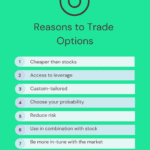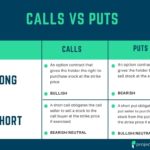Last updated on February 10th, 2022 , 07:24 pm
There are many options trading mistakes that new traders make, and that’s entirely ok! Part of the process when learning anything in life is through mistakes.
With that said, it’s always good to be aware of common “land mines,” so you can make an attempt to avoid them, and ultimately protect your hard-earned money.
In this post, we’ll cover our picks for the top nine options trading mistakes that most new traders will make at some point.
Jump To
1. No Exit Plan
It’s crucial to know exactly when you will close a trade, profitable or unprofitable.
Perhaps the most important thing to know is when you’ll close losing trades that carry a lot of risk, such as being short naked options. When trading limited-risk spreads, it’s ok to be accepting of the maximum loss potential of that position, so long as you’ve sized the position accordingly.
2. Trading Too Many Positions
Some may not agree that this is a mistake, but the fact of the matter is that it’s more difficult to keep track of your portfolio when you trade more and more positions.
Additionally, it’s likely that your positions are highly correlated, which means you’re really trading similar positions in different stocks. It’s ok to have multiple positions in different stocks, just be aware that they may react the same way when markets get volatile.
Lastly, during extremely volatile trading sessions, getting filled on your trades is next to impossible. If you have on 20 positions, good luck making timely adjustments in those positions at decent prices.
The only caveat to this particular point is that if you’re a brand new trader, you’ll benefit from more positions because you’ll gain more experience in regards to strategies and trade outcomes.
3. Trading Illiquid Products
Getting trapped in an option position that will be impossible to close can be costly. If you enter a position in options that are illiquid (very little to no volume or open interest), then it’s likely you’ll be exiting that position at a very unfavorable price
At the very minimum, trade options with open interest in the 1,000s and volume in the 100s (though volume will be lower early in the trading session).
4. Trying to Fix Entirely Broken Trades
Trying to fix broken trades is another common options trading mistake. At some point, the trade is no longer worth your commissions, and you’d be better off taking the loss and allocating your capital elsewhere.
There will always be another trading opportunity, so don’t waste your time trying to repair something that has a very low probability of getting fixed.
5. Taking Profits Too Soon
While taking profits on a trade is not a bad thing, creating a strategy that revolves around taking tiny profits may seem logical at first, as your probability of success will be incredibly high (90% or higher in some cases).
However, you must keep in mind that such approaches require you to have a very high success rate, as the inevitable losses will likely consume a good portion of your profits from winning trades.
Furthermore, commissions will eat into your returns when you take small profits, so try and let your profits run a little longer. A recent iron condor study we conducted showed that the 25% profit target combinations resulted in the lowest profit expectancy over time (sometimes negative when adjusting for estimated commissions), despite having success rates over 90%.
Of course, the strategy you implement should also be considered. For example, long calendar spreads are one example of trades that are typically closed at profit targets of 10-20%, as they don’t often reach profit levels of 50-100% on the debit paid. Another strategy in which profits are typically taken sooner is the short straddle, as the probability of reaching 50-100% of the profit potential is typically low.
6. Trading Too Big
This list of trading mistakes wouldn’t be complete without mentioning trade size.
Trading involves losses, and you can’t allow one losing trade to take you out. As a general guideline, you shouldn’t risk more than 2.5% of your portfolio in a short-term option position. Of course, this may vary based on risk tolerance, and it will be harder to comply with in smaller trading accounts, but don’t put 50% of your portfolio into a single option position!
If you’re trading longer-term options as a way to get leveraged exposure (such as buying 1-2 year call options on an equity), you may be able to get away with increasing your allocation.
7. Not Analyzing Implied Volatility
Implied volatility can be used to assess how “expensive” or “cheap” option prices currently are.
You should always analyze implied volatility before entering a trade to ensure that you won’t be battling changes in IV if your stock price outlook turns out to be correct.
One example of this would be buying call options after a severe market downturn. Typically, when stocks fall considerably, option prices get bid up and implied volatility rises. If you buy a call option in anticipation of a market increase, you might not make money if the market doesn’t increase enough to offset the inevitable decrease in implied volatility.
8. Not Checking for Market Catalysts
It’s always a good idea to make sure you’re aware of any upcoming events that could cause your stock to shift substantially in either direction.
More specifically, if a stock’s implied volatility has been rising and seems lofty, it’s usually for a good reason.
In regards to individual equities, earnings announcements will often cause a stock’s option prices to decay more slowly, leading to an increase in implied volatility as the earnings date approaches.
After the market catalyst passes and the uncertainty dissipates, option prices will change accordingly, but the stock/market may change significantly in one direction.
Be aware of such events before entering trades.
9. Trading Complex Products Without Researching Them First
There are some complicated products out there, particularly in the leveraged ETF and volatility space. Don’t worry! It takes some time to grasp how some of these products work. Just be sure that you read about them before trading them, as it will help avoid unexpected outcomes.
As an example, don’t sell that put spread in VXX until you understand what drives its movements!
That wraps up our picks for common options trading mistakes (in our opinion)!

New to options trading? Learn the essential concepts of options trading with our FREE 160+ page Options Trading for Beginners PDF.
projectfinance Options Tutorials

About the Author
Chris Butler received his Bachelor’s degree in Finance from DePaul University and has nine years of experience in the financial markets.
Chris started the projectfinance YouTube channel in 2016, which has accumulated over 25 million views from investors globally.



